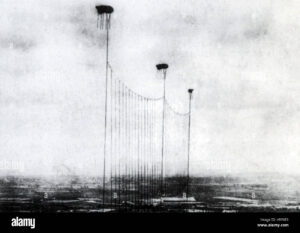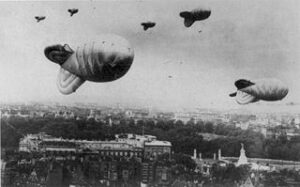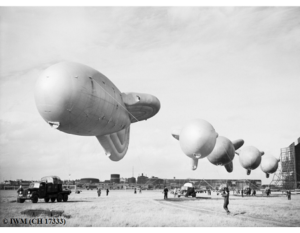Forgotten Friday – Barrage Balloons and the Defence of Britain By Trish Wade
During World War Two Fighter and Bomber Command were the most well-known Royal Air force Sections, however, there was another Command which many people are not aware of, although many have seen the photographs of the big silver spherical balloons hanging in the sky, this was Balloon Command
Barrage Balloons were originally developed during WWI. The French and Germans had kite balloons whilst the British early balloons were spherical. At that time ‘barrage nets’ , which were steel cables, could be strung up between balloons. These could be put up to a height which was high enough to down German bombers which, in that period, had a ceiling height of around 15,000 feet. During WWI it was mainly London that had theses defences. It is thought that by 1918 there were around 50 miles of barrage defences over London.

In November 1938, when there was a sense of an approaching war, Barrage Command was formed and came under the control of Fighter Command. It was based at RAF Stanmore in Middlesex. Initially Air-Vice Marshall Boyd was put in command but following his capture, after making a forced landing in Sicily, on his way to Malta and taken as a prisoner of war, Air Marshall Leslie Gossage took charge in December 1940.
Balloon Command was made up of 5 groups in the United Kingdom. Each group was responsible for the Balloon centres in its region. The groups had their headquarters at:
No. 30 Group at Chessington
No. 31 Group at Birmingham
No. 32 Group at Claverton
No. 33 Group at Shefffield
No. 34 Group at Edinburgh
There were nearly a hundred balloon squadrons in total per region.
The balloons played a major role in the anti-aircraft defences of Britain. In the summer of 1940 Balloon Command had around 1,470 balloons defending every major port and quay plus all the large cities and towns, over a third of them were over London. They restricted the routes which the enemy could fly to their targets and also by being kept higher it was easier for the anti-aircraft guns to keep them in their sights. However, there was also a disadvantage to using barrage balloons, it could also give the enemy information as to where the targets could be if they were heavily defended.

A barrage balloon was a considerable size, around 64 feet (19.5 metres) in length (nearly the length of 3 cricket pitches), 31 feet (9.5 metres) high and had a diameter of 25 feet (7.62 metres). They weighed 600 pounds (272 kg). The balloons were constructed using several panels of fabric and had 3 tail fins at the back. The main part of the balloon was inflated with hydrogen gas and the bottom section was an air-filled ballonet which was kept inflated by wind pressure when the balloon was a certain height. The tailfins also inflated by wind pressure. When the wind was light, the tails often looked deflated but eventually filled with air. The hydrogen could seep out of the balloons, so they had to topped up daily at the sites at which they were thethered.
The balloons were originally held in place by ropes but due to the fragility of them, they were replaced by steel cables which were secured either to the ground or to the backs of lorries and could be flow at heights of around 5,000 feet. At this height it forced enemy bombers to fly higher and made hitting their targets much more difficult. If enemy aircraft happened to hit the cables it would be destroyed, as did shooting at the balloon because the hydrogen would explode, and the aircraft would be caught in the explosion.
It was a physically tough and dangerous job working on the balloons, if one was shot down then the falling balloon or the steel cables came down, they could very easily kill or maim a person if they were underneath one.

Who were the people involved in this oft times dangerous job?
Balloon Command decided that it would be better to train larger numbers of women for this job, freeing up more men for active service, and in 1940 it was decided to train members of the WAAF (Women’s Auxiliary Air Force). It was a 10-week training course and in 1941 the first of the women started their training. By 1942 15,700 WAAF’s had replaced over 10,000 men as balloon operators.
The balloons were not always kept permanently in the air due to the danger to our own aircraft. When a raid was taking place the RAF plotters would inform the balloon operators how high the balloons needed to be. This could happen several times a day.
By Autumn 1944 the need for the balloons was no longer necessary and had finished in Britain.
Balloon Command was disbanded in February 1945.

